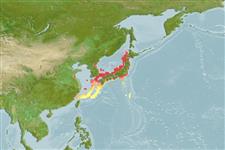Common names from other countries
Environment: milieu / climate zone / depth range / distribution range
Ecologia
marinhas demersal; oceanódromo (Ref. 51243); intervalo de profundidade 139 - 155 m (Ref. 27311). Temperate; 50°N - 26°N, 120°E - 152°E
Northwest Pacific: Japan, the southern Korean Peninsula to the Yellow Sea (Ref. 5590; including the coast of Primorye (Ref. 114081).
Comprimento de primeira maturação / Tamanho / Peso / Idade
Maturity: Lm 19.1 range ? - ? cm
Max length : 57.0 cm TL macho/indeterminado; (Ref. 40637); peso máx. publicado: 2.4 kg (Ref. 40637)
Occurs in rocky coastal areas; often gather around artificial reefs. Breeds from October to December. The egg masses are attached to small rocks, guarded by the male (Ref. 559 and 637). Commercially cultured in Japan.
Male guards eggs.
Masuda, H., K. Amaoka, C. Araga, T. Uyeno and T. Yoshino, 1984. The fishes of the Japanese Archipelago. Vol. 1. Tokai University Press, Tokyo, Japan. 437 p. (text). (Ref. 559)
Status na Lista Vermelha da UICN (Ref. 130435)
CITES (Ref. 128078)
Not Evaluated
Ameaça para os humanos
Harmless
Uso pelos humanos
Pescarias: espécies comerciais; peixe esportivo: sim
Ferramentas
Relatórios especiais
Baixar XML
Fontes da internet
Estimates based on models
Preferred temperature (Ref.
115969): 2.1 - 14, mean 5.7 (based on 7 cells).
Índice de diversidade filogenética (Ref.
82804): PD
50 = 0.5159 [Uniqueness, from 0.5 = low to 2.0 = high].
Bayesian length-weight: a=0.00479 (0.00200 - 0.01144), b=3.12 (2.91 - 3.33), in cm Total Length, based on LWR estimates for this (Sub)family-body shape (Ref.
93245).
Nível Trófico (Ref.
69278): 3.8 ±0.3 se; based on diet studies.
Resiliência (Ref.
120179): médio(a), tempo mínimo de duplicação da população 1,4 - 4,4 anos (Preliminary K or Fecundity.).
Fishing Vulnerability (Ref.
59153): Low to moderate vulnerability (34 of 100).
